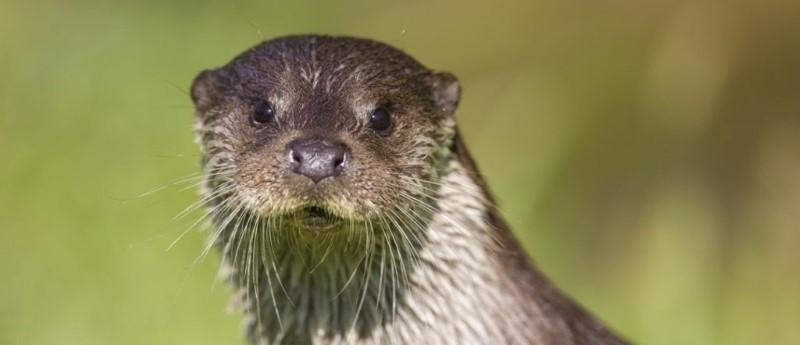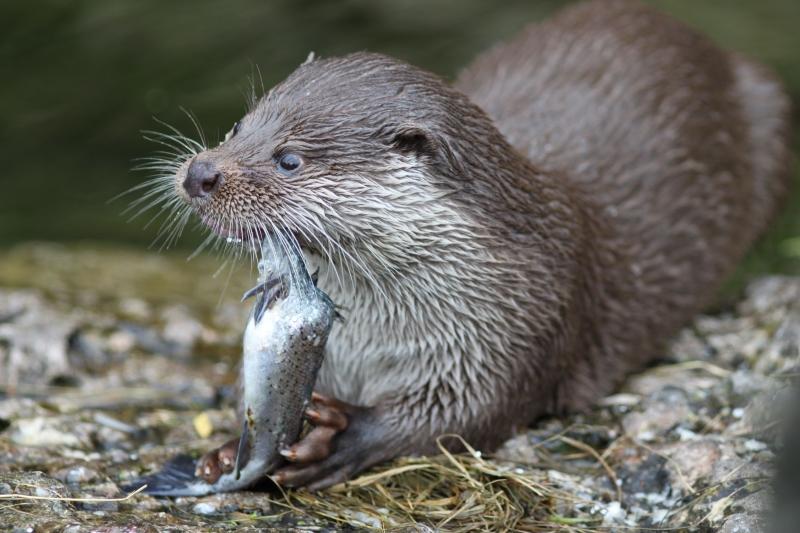
The Eurasian otter
The elusive Eurasian otter (Lutra lutra) is one of the UK’s most memorable mammals to catch a glimpse of in the wild. The only native UK otter species, the Eurasian otter is a European protected species and is also protected under the Wildlife and Countryside Act 1981.
Otter habitat, home and diet
Spotted sliding down banks on their bellies before elegantly gliding into water, or wrestling with siblings, the playful and charismatic behaviour of otters could ignite curiosity in us all.
Although considered rare, otters are widespread in the UK and live in a variety of aquatic habitats, such as lakes, rivers, streams, marshes, and coastal areas.
Their occurrence correlates with bankside vegetation, as they require cavities among tree roots, holes in riverbanks or piles of rock or wood as shelter to breed. They have their cubs in underground burrows, known as ‘holts’.
Otters are top predators, using both the aquatic and terrestrial world, with fish consisting of 80% of their diet, as well as insects, reptiles, amphibians, birds, small mammals, and crustaceans. They are nocturnal but can be seen active at dusk and dawn.

A sensitive bunch
Since the pre-industrial times, otters have declined by 87% around the world. Once widespread throughout the British Isles, numbers began dropping around 1957, and by the mid 1970’s their once high population became limited to small fragmented populations.
A range of factors influenced their decline and still affect otters currently, including habitat loss, pollution, human disturbance, falling fish stocks, insecticides, the illegal wildlife trade and hunting.
Otters are what can be referred to as bio indicators, which means they are heavily affected by the quality of their environment. They need clean, good quality water, so when pesticides being used in agriculture in the 20th century leaked into rivers contaminating fish, there were serious impacts on otters.
A welcome return for most, but not everyone
These pesticides were banned, and in the early 1980’s a reintroduction programme was established to help otters return to their natural homes in the UK. Despite being one of the greatest conservation success stories in the UK, it was not welcomed by everyone.
There are concerns by some commercial fishery owners about the return of these elite aquatic hunters taking prize specimen fish, so there have been calls for otter culls.
It is an offence to disturb, capture, kill or injure an otter under any circumstance as they are protected in the UK under the Wildlife and Countryside Act, 1981.
Earlier this year, in March 2020, a caravan park owner was jailed for shooting an otter after setting an illegal trap because he was unhappy about losing valuable fish and did not want to spend money on fencing.
How can anglers and otters live in harmony?
The balance in a healthy ecosystem should support both predator and prey. Fences help to deter otters, but do not always work.
Over the past two years, groups such as the UK Wild Otter Trust, Angling Trust and the Predation Action Group have joined together along with fishery owners to address this situation. This resulted in Natural England recently issuing the first licence allowing trapping and removal of otters from within a fenced fishery.
For the modern world to move forward and remain connected and balanced with the natural world around us, it is important for people to come together to create solutions which benefit both animals and people alike. After all, in protecting nature we are protecting ourselves and the future generations to follow.
Are there otters in your area?
Their secretive nature makes the otter a challenging species to spot, however they do leave clues to look out for.
In the words of Simon Cooper in his book ‘The Otter’s tale’: “Otters hold an almost unique place in the animal kingdom of the British Isles – they are found in every county, but are so rarely seen that they have been raised to mythical status.”
Muddy or sandy banks by rivers make great slides for otters to glide down into the water, so keep an eye out for slipways! Another tell-tale sign are otter “spraints” which is the name of their droppings, which are usually an ashy-grey colour full of small bones and fish scales.
How you can help otters
Otters are now found in waterways throughout the UK, including those in the Heart of England Forest, and the population has continued to increase over the last 25 years. However, there are still only around 10,000 recorded otters in the UK.
If you ever see a sign or a glimpse of an otter, be sure to let us know through Facebook, Instagram or Twitter, or by emailing us at info@heartofenglandforest.org. You can also record sightings at the Warwickshire Biological Records Centre or Worcestershire Biological Records Centre.
The Mammal Society’s Mammal Mapper App is a great way of building up a library of the mammals you have spotted, whilst helping the Mammal Society understand the distribution, numbers and conservation status of British mammals.



